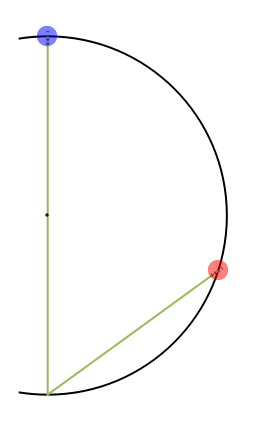Galileo's Paradox
Galileo's Paradox
The blue bead falls straight down to the bottom of the circle along the vertical green wire.
The red bead starts at a lower point and slides without fraction diagonally, finishing at the same point as the blue bead.
Can you predict which bead will reach the bottom first?
Activate the trigger to find out!
Can you explain the result? (Click the hints for help.)
Details
Details
Falling objects seem familiar but their behavior can often be contrary to intuition. Here is a chance to see if you can predict the results of a "race" between two bodies falling along different paths towards the same point. Click the "Play" (right arrow ▶) button to start the race and find out! You can use the slider at the left to change the red ball's starting point. Does that change the outcome? Can you explain the results qualitatively? Can you calculate the times of descent for both balls and resolve Galileo's paradox? The snapshots show various starting positions for the red ball. This problem was first mentioned in 1602 by Galileo; see D. B. Meli, Thinking with Objects, Baltimore: Johns Hopkins University Press, 2006 p. 71.
Resolution of the paradox:
Both objects start from rest and are accelerated uniformly by gravity. Therefore the distances traveled (D and L), their accelerations and ), and the times elapsed and ) are related as follows:
(
a
blue
a
red
(
t
blue
t
red
D=
1
2
a
blue
2
t
blue
L=
1
2
a
red
2
t
red
The blue bead accelerates at . Therefore, .
g=9.8m/
2
s
D=9.8
1
2
2
t
blue
Solving for yields: =.
t
t
blue
2D
9.8
However, the red bead moves diagonally and its acceleration is, therefore, proportionally smaller. From the diagram, you can see that acceleration of the red bead will be the diagonal component of acceleration of the blue bead, that is, =9.8sin(θ). Substituting into yields
a
red
D=
1
2
a
red
2
t
red
L=9.8sin(θ)
1
2
2
t
red
Finally, you can see from the diagram that . Substituting this into the equation immediately above yields:
sin(θ)=
L
D
L=9.8
1
2
L
D
2
t
red
Solving for yields: =.
t
red
t
red
2D
9.8
This agrees with the time for the blue bead and resolves the paradox.
A faster solution is to divide the two equations and , which yields:
L=
1
2
a
red
2
t
red
D=
1
2
a
blue
2
t
blue
L
D
a
red
2
t
red
a
blue
2
t
blue
L
D
a
red
a
blue
Source: T. B. Greenslade, Jr., "Galileo's Paradox," The Physics Teacher, 46(5), 2008 p. 294.
External Links
External Links
Permanent Citation
Permanent Citation
Fernand Brunschwig
"Galileo's Paradox"
http://demonstrations.wolfram.com/GalileosParadox/
Wolfram Demonstrations Project
Published: March 7, 2011
